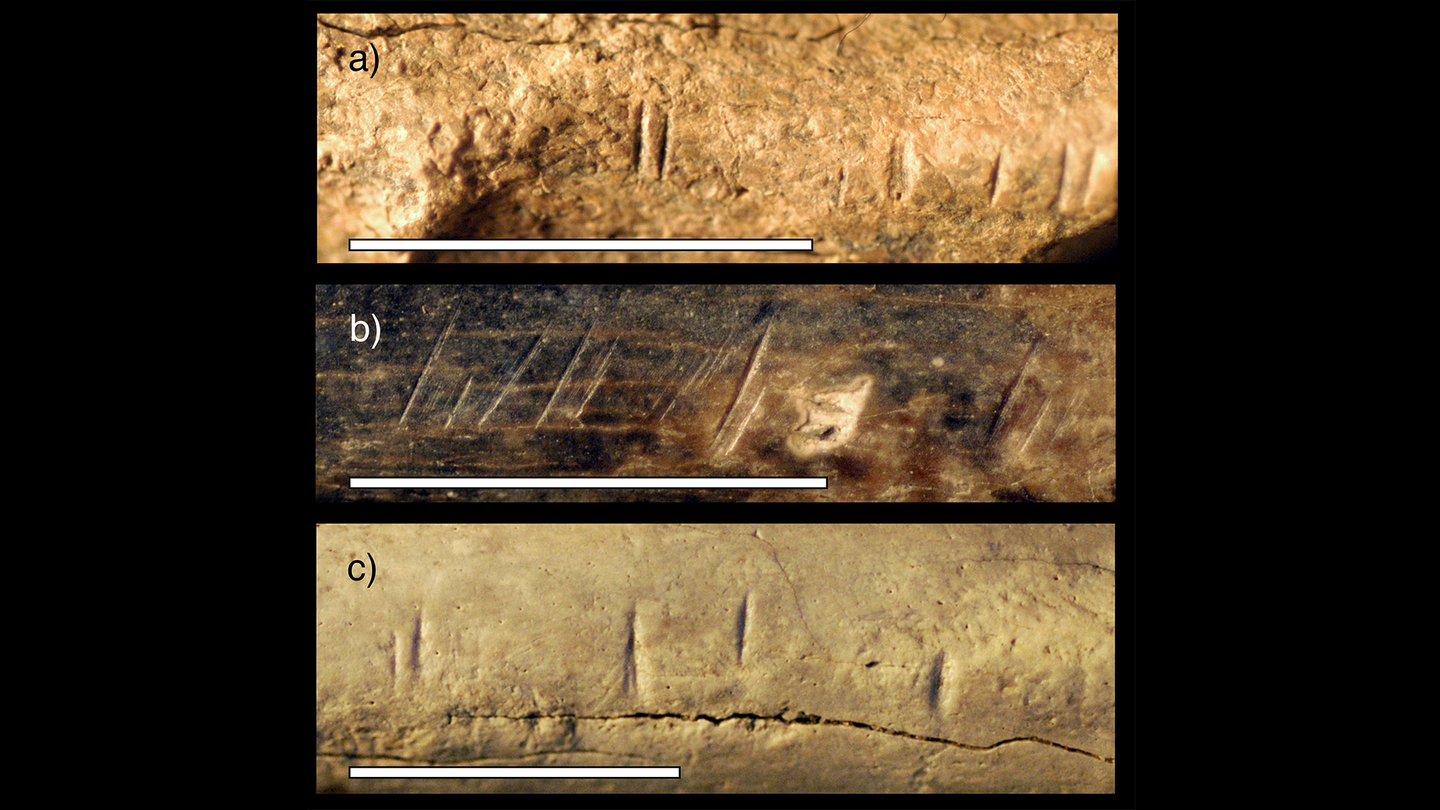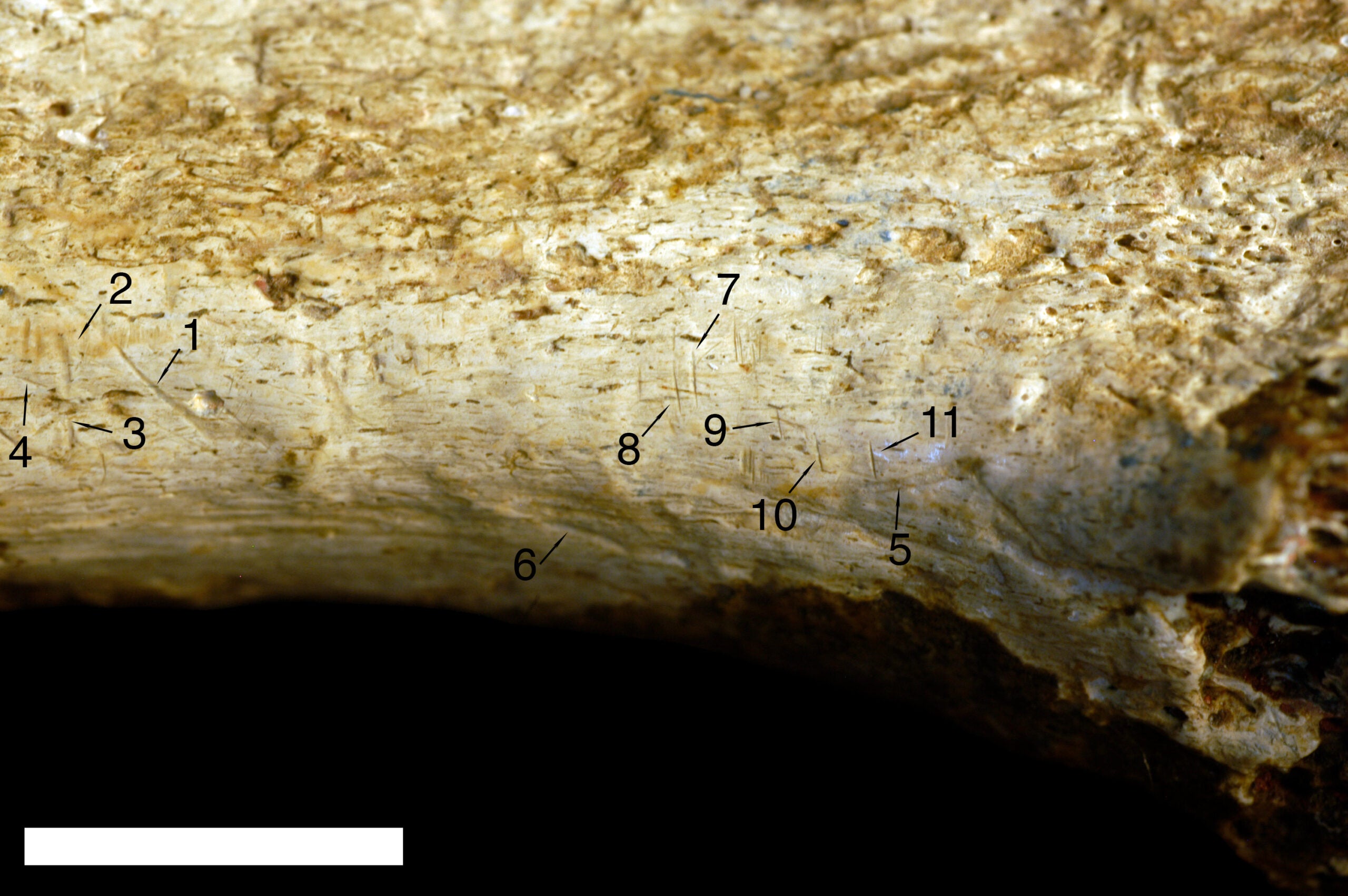Cut-up prehistoric bone raises questions about early human cannibalism
Markings on a fossilized tibia make for a bloody ‘whodunnit’ 1.45 million years in the making.

From the doomed real-life crewmembers of the Nineteenth Century whaleship Essex to the fictional yet grisly soccer-player on soccer-player crime in season 2 of the hit-series Yellowjackets, cannibalism grips our minds in both fiction and the real world.
In a study published June 26 in the journal Scientific Reports, a team of researchers from the Smithsonian describe what could be the oldest decisive evidence of our close evolutionary relatives butchering—and likely eating—one another.
The team examined a 1.45-million-year-old left shin bone from an unknown Homo sapien relative that was found in northern Kenya. The bone has nine cut marks, and analysis of 3D models of the fossil showed that they are very close to the damage that is inflicted by stone tools. According to the team, this is the oldest instance of this behavior known with a high degree of confidence and specificity.
“The information we have tells us that hominins were likely eating other hominins at least 1.45 million years ago,” study co-author and National Museum of Natural History paleoanthropologist Briana Pobiner said in a statement. “There are numerous other examples of species from the human evolutionary tree consuming each other for nutrition, but this fossil suggests that our species’ relatives were eating each other to survive further into the past than we recognized.”
The fossilized tibia was housed in the National Museums of Kenya’s Nairobi National Museum collections. Pobiner encountered them while searching for clues on which prehistoric predators could have hunted and eaten our ancient relatives and she noticed the evidence of butchery while checking the bone for bite marks.
Pobiner sent molds of these cuts to co-author Michael Pante of Colorado State University to try to figure out if these were actually cut marks. Pante created 3D scans of the molds and then compared the shape of the marks with a database of 898 individual tooth, butchery, and trample marks that were created through controlled experiments.
According to the analysis, nine of the 11 total marks were positively identified as clear matches for the type of damage inflicted by stone tools. The remaining two marks were likely a big cat’s bite marks, with a lion being the closest match. The bite marks also could have come from one of the three different types of saber-tooth cats that prowled the landscape at this time.
The cut marks alone do nor prove that whomever butchered the owner of this leg made a meal out of them, but Pobiner believes that this seems to be the most likely scenario. The markings are located where the calf muscle would have attached to the bone, which is a good place to cut if the assailant’s goal was to remove a chunk of flesh. Additionally, the cut marks are all oriented the same way, suggesting that a hand wielding a stone tool may have made the marks in succession without changing their grip or adjusting the angle.
[Related: Lucy, our ancient human ancestor, was super buff.]
“These cut marks look very similar to what I’ve seen on animal fossils that were being processed for consumption,” Pobiner said. “It seems most likely that the meat from this leg was eaten and that it was eaten for nutrition as opposed to for a ritual.”
On the surface, it looks like this could be an example of prehistoric cannibalism, but cannibalism requires the eater and the eaten to be of the same species. Initially, the shin bone was identified as Australopithecus boisei and then as Homo erectus in 1990. Today, experts agree that there is not enough conclusive information to know what species of hominin the bone belongs to. The use of stone tools also doesn’t narrow down which species might have been the butcher.

This fossil could be a trace of prehistoric cannibalism, but also may have been a case of one species making a meal out of its evolutionary cousin.
Since none of the stone-tool cut markings overlap with two bite marks, it makes it even harder for scientists to infer anything about the order of events that took place when this hominin lost its leg. It’s possible that a big cat may have scavenged the remains after other hominins removed most of the meat from the leg bone, or that a big cat killed this unlucky prehistoric human and was chased off by other hominins that wanted to take over the kill.
A fossilized skull first discovered in South Africa in 1976 previously sparked debate about the earliest known case of human relatives butchering each other. This skull was roughly 1.5 to 2.6 million years old. Studies on the skull from 2000 and 2018 disagreed about the origin of the marks left on the skull’s right cheek bone. One proposes that the marks were the result from stone tools used by hominid relatives, while the other study asserts that the marks were formed through contact with sharp-edged stone blocks that were found lying against the skull. If ancient hominins actually did use tools to put marks on the skill, it still isn’t clear if they were butchering each other for food, due to a lack of large muscle groups on the skull.
In future tests to determine once and for all that the fossilized tibia in this new study is actually the oldest cut-marked hominin fossil, Pobiner said she would love to reexamine the skull from South Africa, since it potentially has cut marks that were made using similar techniques observed in her new study.
The findings are also another example of the treasures that could be lurking in museum drawers and cupboards around the world just waiting to be uncovered.
“You can make some pretty amazing discoveries by going back into museum collections and taking a second look at fossils,” Pobiner said. “Not everyone sees everything the first time around. It takes a community of scientists coming in with different questions and techniques to keep expanding our knowledge of the world.”
Related Post
A shocking documentary proves that mermaids do exist
SHOCKING Revelation: Thuya, Mother of Queen Tiye, Was the Grandmother of Akhenaten and Tutankhamun—What Ancient Egyptian Secrets Did She Leave Behind?
Breaking News: Astonishing Discoveries at Karahan Tepe Confirm an Extraterrestrial Civilization is Hiding on Earth, and NO ONE Knows!
Breaking News: Researchers FINALLY Discover U.S. Navy Flight 19 After 75 Years Lost in the Bermuda Triangle!
NASA’s Secret Investigation: Uncovering the Astonishing Mystery of the UFO Crash on the Mountain!
Explosive UFO Docs LEAKED: Startling Proof That Aliens Ruled Ancient Egypt!